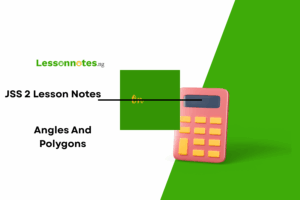Area & Perimeter of Plane Shapes JSS1 Mathematics Lesson Note
Download Lesson NoteTopic: Area & Perimeter of Plane Shapes
AREA AND PERIMETER OF PLANE SHAPES
PERIMETER: The perimeter of a plane shape is the length of its outside boundary. This means the distance around its edges.
Examples
- The length of a rectangular room is 5m and the width is 4m. Find the perimeter of the room
Solution
The length of the room is 5 m.
The width of the room is 4 m.
Perimeter = 2(l+w)
Perimeter = 2(5+4)
Perimeter = 2(9) = 2×9 = 18m
The perimeter of a square is 2580 cm.
Find the length of the square in meters.
Solution:
P= 2580cm = 25.8m
P= 4 x length = 4l
L = 25.8/4
L = 6.45m
Therefore, the length of the square = 6.45m
Calculate the perimeter of a triangle with dimensions 4.2m, 3.6m, and 5.7m.
Solution:
Perimeter = (4.2 + 3.6 + 5.7) meters
Perimeter = 13.5m
A parallelogram has sides measuring 200mm by 150mm. what would be the length of the side of a square having the same perimeter?
Solution
Length of parallelogram = 200mm
The width of the parallelogram = 150mm
Perimeter = 2( L + w)
Perimeter = 2(200 + 150) mm
Perimeter = 2 x 350 = 700mm
But
Perimeter of the square = 4 x length = 4L
4L = 700mm
Divide both sides by the coefficient of l
L = 700/4 = 175
Therefore the length of the square = 175mm
Calculate the perimeter of a circle of diameter 14cm.
NOTE: The perimeter of a circle is called circumference and the diameter (D) is twice the radius (r). thus D = 2r
Solution:
Method 1: circumference = πd
C=πd
C = 22/7 x 14
C = 44cm
Method 2: ∁ =2πr
R = D/2 = 14/2 = 7cm
C = 2 x 22/7 x 7
C= 44cm
AREA: The area of shapes is the measure of the amount of surface it covers or occupies.
Examples :
Calculate the area of a rectangular room with dimensions 250cm by 200cm.
Solution: A=l x b
A = (250 x 200) square cm
A =50 000 cm square.
Find the area of a square of sides 14cm.
Solution: A=l x l
A = 14 x 14
A = 196 cm square
Evaluate the area of a parallelogram with a base of 8cm and height of 9cm.
Solution:
A=b x h
A = 8 X 9
A = 72 cm square
Calculate the area of a trapezium with parallel sides of 10cm and 18cm and a height of 12cm.
Solution:
Area = 1/2 (sum of parallel sides)x height
Area = ½ (10 + 18) x 12
Area = ½ (28) x 12
Area = 14 x 12
Area = 168 cm square.














